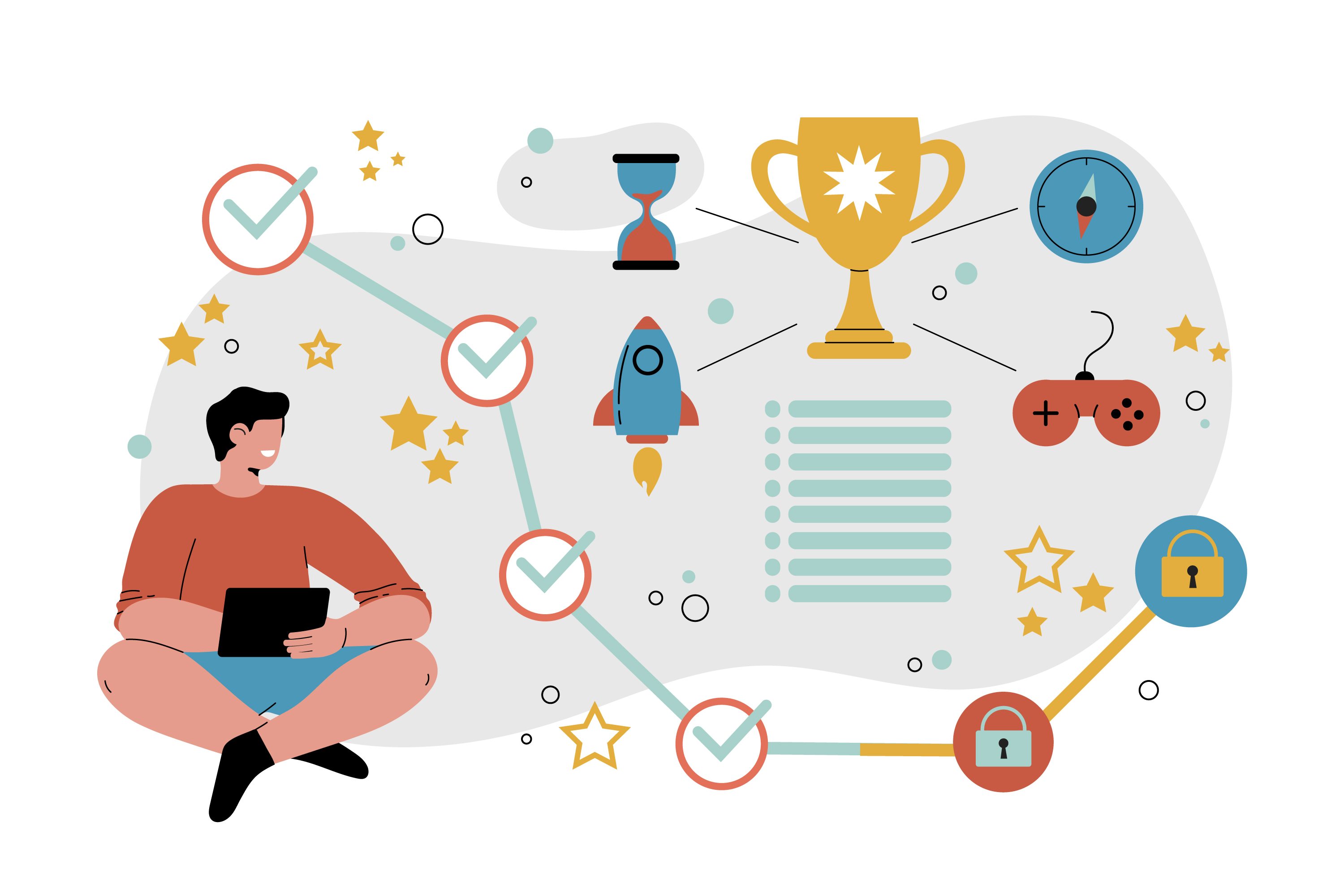Level Up Your Virtual Classroom: Gamification in Online Learning
So, your classroom is a screen. How do you keep your students motivated and connected when their only motivation is a deadline? Online learning can present unique challenges to students: isolated studying, waiting for feedback, and the need to be your own cheerleader, secretary, and manager. This article provides solutions to these challenges through gamification in online learning.
Gamification: A Solution Strategy for Online Instructors
As part of a full pedagogical approach, online instructors are working to combat these challenges by incorporating gamification elements into their teaching methods and strategies. These elements are not designed to turn a course into a video game. Instead, this strategy borrows the psychology of the best parts of games—elements that make tasks addictive and fun—and uses it to level up your virtual classroom.
What Is Gamification?
Gamification uses game design and the psychology of rewards to make online learning more interactive and compelling. Game design is a broad spectrum, including everything from implementing a point system to developing a curriculum that unfolds like a quest. The use of gamification leads to better student engagement, knowledge retention, and a sense of community.
Essential Gamification Elements for a Virtual Classroom
Points, Badges, and Leaderboards (PBLs) for Asynchronous Learning

Points
Students earn points by completing tasks, which can be part of a project or an ongoing tally throughout the course. Points don’t have to be difficult to track because most LMSs can automatically award points for watching lecture videos, completing low-stakes quizzes, or contributing to discussion forums. Point collection is an instant gratification for every small task a student completes.
Although points may be a direct reflection of grades, other effective uses have included task points in an overarching participation grade or extra credit opportunities.

Badges
Students are awarded digital badges as a visual reward for completing online modules or mastering a specific skill. These badges help students to celebrate and to feel celebrated as they complete tasks. Badges can even function as more than a digital high-five—they can be displayed on a student’s profile/e-portfolio.

Leaderboards
A continual standing of student progress, leaderboards can create visible, friendly competition for weekly progress, a crucial motivator in a self-paced environment. Leaderboards are a gentle nudge to stay on track with the rest of the class and, when done well, can allow classmates to cheer each other on in their progress.
Progress Visualization and XP (Experience Points):

Visual Progress
A progress bar helps students skip the overwhelm that can occur from guessing how far they’ve come in the course or on a project. A progress bar on an online course dashboard shows a student’s journey from start to finish, which helps to make their effort tangible and measurable at a glance.

Increasing Experience Points
The best way to motivate students is to present all tasks as a means to level up through the collection of knowledge and completed tasks, which is especially important for maintaining momentum in long, self-paced online courses.
Turning Curriculum into an Online Learning Adventure
Assignments as Quests and Missions
Framing online assignments and projects as quests and missions helps students remove themselves from the mindset of overwhelming deadlines and focus on a narrative. Clear objectives and rewards for completing them can be delivered through a series of prompts and resources within a module. This transforms isolated tasks into a purposeful narrative, guiding students through course material and helping them feel like they are doing more than a chore.
Take It from the Gamers: Boss Battles, Side Quests, and NPCs
Many curriculum units are designed to include at least one major, high-stakes project or assignment with several subprojects leading up to it. The transition to game design becomes easy using this structure.

Boss Battles and Side Quests
In video games and other strategy-based games, the PC (or player character) is tasked with many small objectives, or side quests, that are designed to help the PC collect information and build up to a larger goal. This larger goal is usually considered a boss battle, in which the PC must battle a major antagonist in order to continue on their journey. Likewise, smaller assignments, which are designed to build a foundation of knowledge and challenge students in increments, prepare them to take on a major, high-stakes project before they’re able to unlock the next curriculum unit.

NPCs
In game design, an NPC (or nonplayer character) is someone or something that assists the PC on their journey. In the classroom, NPC can refer to an AI chatbot, a TA, the instructor, and even other students who provide guidance and information throughout the course. When done with purpose, making provisions for support throughout the journey (who, what, when, and how) as part of the game design can help students feel supported, experience teamwork and autonomy in turn, and develop critical thinking skills.
Collaborative Team Guilds
Instead of traditional group work, online teams can be structured as guilds or crews with shared goals and rewards. As with a real-life crew made of many individuals with unique skillsets, framing group work as a guild or crew encourages students to highlight each other’s strengths and contributions while building a sense of camaraderie and directly addressing the issue of isolation in online learning.
Tying Gamification to Learning Objectives
Gamification is a powerful, technology-driven solution to the most common challenges in online education; however, successful gamification in online learning requires careful design to ensure the elements support the learning objectives, not just entertain.
Although gamification typically relies on extrinsic motivators (like points and badges), the true goal of the motivators is to spark students’ intrinsic motivation—a desire to learning simply for the joy of learning. Therefore, care should be taken to avoid focusing only on earning points or creating competition.
One positive approach is to promote game elements as a safe space for failure, where mistakes are seen as opportunities for growth rather than a source of permanent punishment.
Through tying all gamification elements back to learning outcomes and staying focused on the goals of teamwork, feedback, and support, the right mindset can be taught.
Progress Bars, Checking the Map, and More
As with most educational plans, feedback and reflection are an essential part of the process. Fortunately, there are enough aspects and approaches to game design that instructors have the benefit of flexibility in how they set up their gamification strategies. Providing a space for students to review their efforts, growth, and understanding, as well as the details of the gamification strategy during and after a unit, can allow an instructor to revise their strategies as needed.
Beyond the Game
Together, gamification and online LMSs are creating a new pedagogical standard for engaging, effective, and community-driven online education. Gamification is more than just a clever buzzword for online learning; it’s a practical and powerful solution to some of the biggest problems students face.
By weaving in game elements, instructors and LMSs are creating a sense of community that helps prevent isolation in virtual classrooms, providing constant encouragement students need in online learning, and promoting an autonomous growth mindset by allowing learners to fail and try again without a sense of finality. All of these small changes add up to an experience where students are not just participating—they’re truly engaged in and in control of their own education.
To learn more about the psychology behind gamification and to find a resource that provides free games for learners, check out our blog post, “Playing Games and Developing Skills: Gamification in eLearning.”
What Gamification Elements Do MyEducator Resources Offer?








MyEducator’s platform offers the tools to create a gamified, interactive experience, but we don’t just offer isolated tools—our developers have done a fantastic job putting together a platform that allows instructors to build a cohesive and effective gamification strategy, designed to seamlessly integrate with their courses. It offers gamification essential elements, such as auto-graded interactive quizzes, narratives, simulation exercises, points systems, leaderboards that can be shared with students, a percentage-read feature, checkmarks on completed pages, and even ready-made micro-credentials (like digital badges) and certificates for achievements.
For a demo of all the interactive, motivation- and community-building features that MyEducator offers, please reach out to our team via support@myeducator.com.
References
Blankman, R. (2022, January 28). Gamification in education: The fun of learning. HMH Education Company. https://www.hmhco.com/blog/what-is-gamification-in-education?srsltid=AfmBOoovViIRRcdlLzlNNl3GEPHdDc_ePuDXgHj_wMJwwLjsmgBYB76a
Okatta, P. J. (2025). The Psychology of e-learning: Why online courses work (ch.13). Recorded Books.
Ponnusamy, S., Antari, J., Jeon, G., Assaf, M., & Sharma, B. (Eds.). (2025). Revolutionizing education with remote experimentation and learning analytics (pp. 475–478). IGI Global Scientific Publishing. https://doi.org/10.4018/979-8-3693-8593-7
Smithsonian Science Education Center. (2014, January 8). 5 benefits of gamification. STEMvisions Blog. https://ssec.si.edu/stemvisions-blog/5-benefits-gamification
University of San Diego. (n.d.). 10 effective examples of gamification in the classroom. Professional and Continuing Education. https://pce.sandiego.edu/gamification-in-education/








